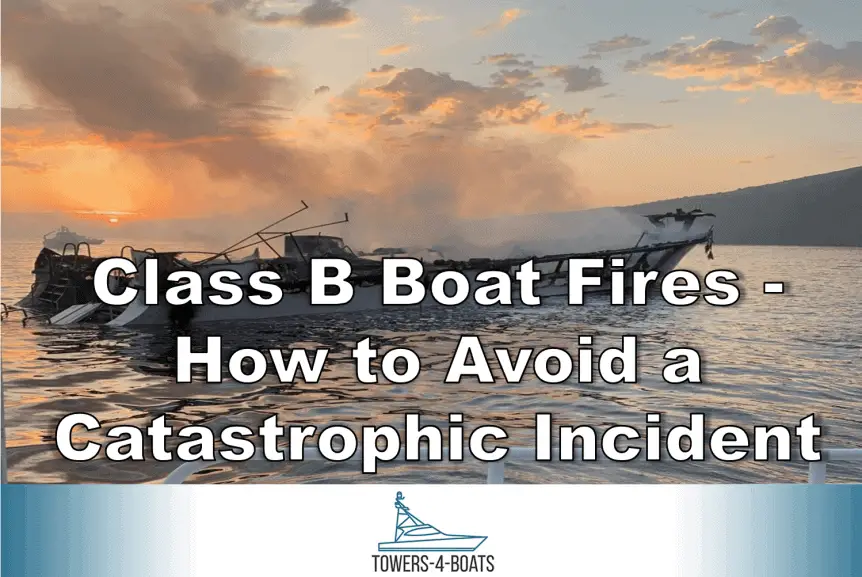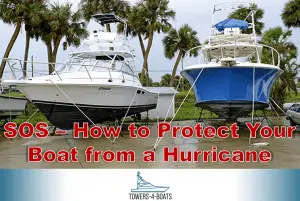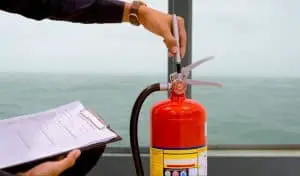What is a Class B Fire?
Fire disasters have a way of irrevocably affecting our lives and boating fires are no exception. To avoid disaster, you need to be able to identify the different categories of fire and know how to best prevent them. The importance of being prepared cannot be overemphasized. This article explains how to identify Class B fires and the best way to handle them. This knowledge will help you enjoy your boating experience without worrying about possible fire hazards.
Check out my article on boat fire extinguishers if you’re looking for a lot of detailed information.
What are the different classifications of fire?
First, it is important to understand that not all fires are the same. While there are fires that are easily quenched with water, some fires escalate when doused with water and can only be put out with a specific model of fire extinguisher. All categories of fire have their own unique fire extinguishers, clearly marked with their specification so they are easily identified in case of an emergency. To be prepared, it is of the utmost importance that you understand the different fire classifications and how to act when faced with them. Here are some of the most common classifications of fire:
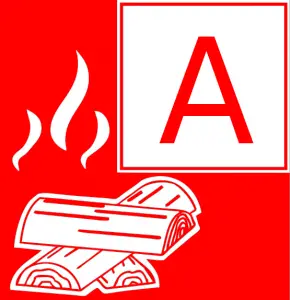 Class A Fires: This refers to fires caused by combustible solids such as wood or trash. A large number of common fires fall under this classification. These can be extinguished with water or a Class A fire extinguisher.
Class A Fires: This refers to fires caused by combustible solids such as wood or trash. A large number of common fires fall under this classification. These can be extinguished with water or a Class A fire extinguisher.
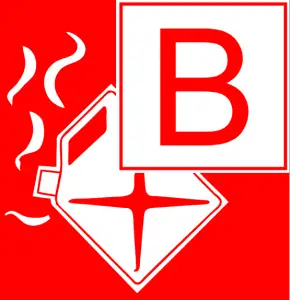 Class B Fires: This category of fire is triggered by flammable liquids like gasoline. It spreads easily and can cause explosions especially if you have large quantities of flammable liquids lying around. Class B fires cannot be doused with water. For instance, gasoline induced fires become more flammable when encountering water, so trying to extinguish it with water will only escalate the fire. Every boat owner should know how to handle a Class B fire.
Class B Fires: This category of fire is triggered by flammable liquids like gasoline. It spreads easily and can cause explosions especially if you have large quantities of flammable liquids lying around. Class B fires cannot be doused with water. For instance, gasoline induced fires become more flammable when encountering water, so trying to extinguish it with water will only escalate the fire. Every boat owner should know how to handle a Class B fire.
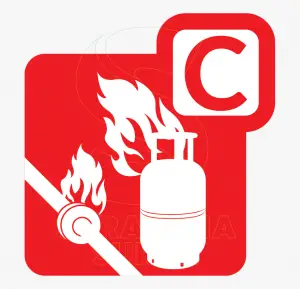 Class C Fires: This class of fire is electrical. The odds of experiencing this type of fire when boating is very low, but it should not stop you from learning how to put it out. Do not try to use water – as water conducts electricity it presents an electrocution hazard.
Class C Fires: This class of fire is electrical. The odds of experiencing this type of fire when boating is very low, but it should not stop you from learning how to put it out. Do not try to use water – as water conducts electricity it presents an electrocution hazard.
 Class D Fires: Class D fires can be traced to combustible metals such as magnesium. This class of fire does not react well to water, which is why you need to use the appropriate fire extinguisher for it. Most boats don’t have combustible metals on them, so you don’t need to worry about this one.
Class D Fires: Class D fires can be traced to combustible metals such as magnesium. This class of fire does not react well to water, which is why you need to use the appropriate fire extinguisher for it. Most boats don’t have combustible metals on them, so you don’t need to worry about this one.
Class A and B fires are the most common boating fires. Class B fires can be doused with any of the following fire extinguishers: dry chemical, carbon dioxide and foam.
Coast Guard Approved 5 Pound ABC Dry Chemical Fire Extinguisher
Quick action and being prepared in case of a fire outbreak can make a huge difference. And while it might not be the obvious first thought during an outbreak, knowing the cause of the fire is actually the first step to extinguishing it. Let’s take a look at the basics of a fire, how it works and what to do to extinguish it.
Boat fire extinguishers don’t last forever. In this article I discuss how to know if your fire extinguisher is still good.
The Fire Triangle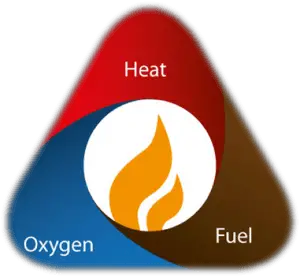
The Fire Triangle is a simple model for understanding the necessary ingredients for most fires. The triangle illustrates the three elements a fire needs to ignite: heat, fuel, and oxygen. A fire naturally occurs when the elements are present, so it’s important to think of fire as an event rather than a thing. Eliminating any of these elements automatically extinguishes the fire.
Heat can be removed by the application water, which absorbs heat for phase change from water to steam or powder or gas extinguisher for a non-Class A fire. Turning off the electricity in an electrical fire removes the ignition source.
Without fuel, a fire will stop. Fuel can be removed naturally (where the fire has consumed all the burnable fuel), or manually, by mechanically or chemically removing the fuel from the fire.
Without sufficient oxygen, a fire cannot continue. Oxygen can be denied to a fire using a carbon dioxide fire extinguisher, a fire blanket or water.
Propane or gasoline fueled fires are very difficult to stop. And the fumes produced by this category of fire are quite heavy and can easily pile up in the cabin and other areas of the boat. These fumes often cause dizziness and nausea, which can incapacitate you and others during a fire.
Preventing fire on your boat
The best way to prevent a fire outbreak on your boat is to make sure the boat is clean.
Most Class B fires start from spills or leaks of combustible liquid. To reduce this hazard factor, you need to keep the bilge, the lower areas, and the cabin area clean and also ensure that there are no spills or trash lying around. The presence of fresh air is an indication that one of the elements of the fire triangle is present. This, combined with trash, leaks and spills, will only need a heat source to ignite.
This heat can come from something as common as a sparkler or even sparks from lighters, or perhaps from one of the ignition components used for starting your boat. Any of these elements can lead to an inferno. Apart from making sure the boat is clean, you must also complete regular checks to ensure that the electrical components, the engine and everything else is in good working condition. Regular inspections will help you detect and eliminate hazards that can lead to a Class B fire.
It is not unusual to see flammable liquids such as alcohol or beauty products on board a boat. These items, though hazardous if handled carelessly, are necessary part of life on a boat. It is impossible to completely eliminate all fire hazards from your boats, so fire prevention and preparedness are essential fire safety measures. Keep at least two fire extinguishers on board, store all hazardous materials in the right place, know the right fire extinguisher for each fire, etc. These are some of the things you have to put into practice to protect yourself and others on board from possible boating fire.
With all the preparation, there is still no guarantee that there will not be a fire outbreak on your boat. If this ever happens, the most important thing to do is act fast. The first few seconds after a fire outbreak are always crucial as it determines the extent and the effect of the fire.
How to put out boating fires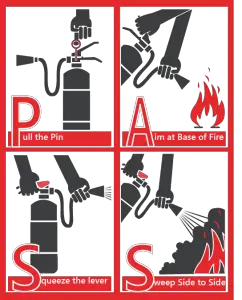
Time is of the essence when putting out fires. You must learn to act fast if you want to prevent the fire from causing any serious damage. First, you need to read and understand the instructions that come with your fire extinguishers. Fire extinguishers will display their classification clearly on the front and come with their own set of instructions which can be found on the container of the extinguisher. The instructions explain what to do if there’s a fire outbreak.
PASS
The best way to remember how to use a fire extinguisher is to employ the acronym P.A.S.S.:
- Pull
- Aim
- Squeeze
- Sweep
Make sure the extinguisher is directed at the base of the fire. The base is the point where the flames gather the fuel for the fire, which is why it should be your first area of attack. Sweeping the solution or foam from one side to the other will smother and cover the fire which automatically eliminates the last two components of the fire triangle, i.e. heat and oxygen.
Remember to keep your fire extinguisher handy. This article explains the best places to store a fire extinguisher on your boat.
Stay safe
The importance of fire safety can never be overemphasized. You must ensure that there are at least two fire extinguishers aboard when boating, and remember other fire safety requirements, such as the correct storage of flammable materials in the appropriate location, having an action plan in case of a fire and teaching those onboard about the classifications of fire and how best to handle them.
Whenever you’re on your boat, remember to always stay safe!
What is a Class B Fire?
Fire disasters have a way of irrevocably affecting our lives and boating fires are no exception. To avoid disaster, you need to be able to identify the different categories of fire and know how to best prevent them. The importance of being prepared cannot be overemphasized. This article explains how to identify Class B fires and the best way to handle them. This knowledge will help you enjoy your boating experience without worrying about possible fire hazards.
Check out my article on boat fire extinguishers if you’re looking for a lot of detailed information.
What are the different classifications of fire?
First, it is important to understand that not all fires are the same. While there are fires that are easily quenched with water, some fires escalate when doused with water and can only be put out with a specific model of fire extinguisher. All categories of fire have their own unique fire extinguishers, clearly marked with their specification so they are easily identified in case of an emergency. To be prepared, it is of the utmost importance that you understand the different fire classifications and how to act when faced with them. Here are some of the most common classifications of fire:
 Class A Fires: This refers to fires caused by combustible solids such as wood or trash. A large number of common fires fall under this classification. These can be extinguished with water or a Class A fire extinguisher.
Class A Fires: This refers to fires caused by combustible solids such as wood or trash. A large number of common fires fall under this classification. These can be extinguished with water or a Class A fire extinguisher.
 Class B Fires: This category of fire is triggered by flammable liquids like gasoline. It spreads easily and can cause explosions especially if you have large quantities of flammable liquids lying around. Class B fires cannot be doused with water. For instance, gasoline induced fires become more flammable when encountering water, so trying to extinguish it with water will only escalate the fire. Every boat owner should know how to handle a Class B fire.
Class B Fires: This category of fire is triggered by flammable liquids like gasoline. It spreads easily and can cause explosions especially if you have large quantities of flammable liquids lying around. Class B fires cannot be doused with water. For instance, gasoline induced fires become more flammable when encountering water, so trying to extinguish it with water will only escalate the fire. Every boat owner should know how to handle a Class B fire.
 Class C Fires: This class of fire is electrical. The odds of experiencing this type of fire when boating is very low, but it should not stop you from learning how to put it out. Do not try to use water – as water conducts electricity it presents an electrocution hazard.
Class C Fires: This class of fire is electrical. The odds of experiencing this type of fire when boating is very low, but it should not stop you from learning how to put it out. Do not try to use water – as water conducts electricity it presents an electrocution hazard.
 Class D Fires: Class D fires can be traced to combustible metals such as magnesium. This class of fire does not react well to water, which is why you need to use the appropriate fire extinguisher for it. Most boats don’t have combustible metals on them, so you don’t need to worry about this one.
Class D Fires: Class D fires can be traced to combustible metals such as magnesium. This class of fire does not react well to water, which is why you need to use the appropriate fire extinguisher for it. Most boats don’t have combustible metals on them, so you don’t need to worry about this one.
Class A and B fires are the most common boating fires. Class B fires can be doused with any of the following fire extinguishers: dry chemical, carbon dioxide and foam.
Coast Guard Approved 5 Pound ABC Dry Chemical Fire Extinguisher
Quick action and being prepared in case of a fire outbreak can make a huge difference. And while it might not be the obvious first thought during an outbreak, knowing the cause of the fire is actually the first step to extinguishing it. Let’s take a look at the basics of a fire, how it works and what to do to extinguish it.
Boat fire extinguishers don’t last forever. In this article I discuss how to know if your fire extinguisher is still good.
The Fire Triangle
The Fire Triangle is a simple model for understanding the necessary ingredients for most fires. The triangle illustrates the three elements a fire needs to ignite: heat, fuel, and oxygen. A fire naturally occurs when the elements are present, so it’s important to think of fire as an event rather than a thing. Eliminating any of these elements automatically extinguishes the fire.
Heat can be removed by the application water, which absorbs heat for phase change from water to steam or powder or gas extinguisher for a non-Class A fire. Turning off the electricity in an electrical fire removes the ignition source.
Without fuel, a fire will stop. Fuel can be removed naturally (where the fire has consumed all the burnable fuel), or manually, by mechanically or chemically removing the fuel from the fire.
Without sufficient oxygen, a fire cannot continue. Oxygen can be denied to a fire using a carbon dioxide fire extinguisher, a fire blanket or water.
Propane or gasoline fueled fires are very difficult to stop. And the fumes produced by this category of fire are quite heavy and can easily pile up in the cabin and other areas of the boat. These fumes often cause dizziness and nausea, which can incapacitate you and others during a fire.
Preventing fire on your boat
The best way to prevent a fire outbreak on your boat is to make sure the boat is clean.
Most Class B fires start from spills or leaks of combustible liquid. To reduce this hazard factor, you need to keep the bilge, the lower areas, and the cabin area clean and also ensure that there are no spills or trash lying around. The presence of fresh air is an indication that one of the elements of the fire triangle is present. This, combined with trash, leaks and spills, will only need a heat source to ignite.
This heat can come from something as common as a sparkler or even sparks from lighters, or perhaps from one of the ignition components used for starting your boat. Any of these elements can lead to an inferno. Apart from making sure the boat is clean, you must also complete regular checks to ensure that the electrical components, the engine and everything else is in good working condition. Regular inspections will help you detect and eliminate hazards that can lead to a Class B fire.
It is not unusual to see flammable liquids such as alcohol or beauty products on board a boat. These items, though hazardous if handled carelessly, are necessary part of life on a boat. It is impossible to completely eliminate all fire hazards from your boats, so fire prevention and preparedness are essential fire safety measures. Keep at least two fire extinguishers on board, store all hazardous materials in the right place, know the right fire extinguisher for each fire, etc. These are some of the things you have to put into practice to protect yourself and others on board from possible boating fire.
With all the preparation, there is still no guarantee that there will not be a fire outbreak on your boat. If this ever happens, the most important thing to do is act fast. The first few seconds after a fire outbreak are always crucial as it determines the extent and the effect of the fire.
How to put out boating fires
Time is of the essence when putting out fires. You must learn to act fast if you want to prevent the fire from causing any serious damage. First, you need to read and understand the instructions that come with your fire extinguishers. Fire extinguishers will display their classification clearly on the front and come with their own set of instructions which can be found on the container of the extinguisher. The instructions explain what to do if there’s a fire outbreak.
PASS
The best way to remember how to use a fire extinguisher is to employ the acronym P.A.S.S.:
- Pull
- Aim
- Squeeze
- Sweep
Make sure the extinguisher is directed at the base of the fire. The base is the point where the flames gather the fuel for the fire, which is why it should be your first area of attack. Sweeping the solution or foam from one side to the other will smother and cover the fire which automatically eliminates the last two components of the fire triangle, i.e. heat and oxygen.
Remember to keep your fire extinguisher handy. This article explains the best places to store a fire extinguisher on your boat.
Stay safe
The importance of fire safety can never be overemphasized. You must ensure that there are at least two fire extinguishers aboard when boating, and remember other fire safety requirements, such as the correct storage of flammable materials in the appropriate location, having an action plan in case of a fire and teaching those onboard about the classifications of fire and how best to handle them.
Whenever you’re on your boat, remember to always stay safe!

